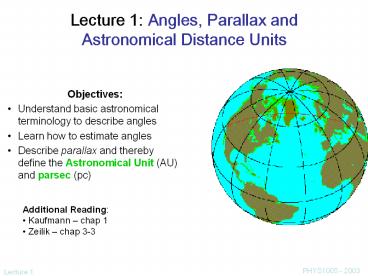Lecture 1: Angles, Parallax and Astronomical Distance Units - PowerPoint PPT Presentation
1 / 8
Title:
Lecture 1: Angles, Parallax and Astronomical Distance Units
Description:
Lecture 1: Angles, Parallax and Astronomical Distance Units. Objectives: ... Describe parallax and thereby define the Astronomical Unit (AU) and parsec (pc) ... – PowerPoint PPT presentation
Number of Views:278
Avg rating:3.0/5.0
Title: Lecture 1: Angles, Parallax and Astronomical Distance Units
1
Lecture 1 Angles, Parallax and Astronomical
Distance Units
- Objectives
- Understand basic astronomical terminology to
describe angles - Learn how to estimate angles
- Describe parallax and thereby define the
Astronomical Unit (AU) and parsec (pc)
- Additional Reading
- Kaufmann chap 1
- Zeilik chap 3-3
2
Basics
- Early Astronomy all about measuring angles
- 360 2p rad 1 full circle
- Astronomers also use arcminutes and arcseconds,
where - 1 degree 60 arcmins 3600 arcsecs
- 1 60 3600
- Also useful to know that
- 1 rad 360/2p 57.3 206,265
- Angular diameter of the Sun and Moon are 30
- This system inherited (as was time) from the
ancient Babylonians who counted in a base-60
(sexagesimal) system - Try estimating the angle between two points on
the blackboard it will be different for
different rows! - Now try it with this rule-of-thumb as a guide
- hold your hand outstretched at arms length
- tip of your little finger to that of your thumb
subtends 20 - similarly, the tip alone of your index finger
subtends 1 (i.e. about twice diameter of Sun
or Moon!)
3
Small angle approximations
- Astronomical angles often small ? can avoid
trigonometry! - formally, tan(a/2)(l/2)/d
- but, for ? 1, tan ? ? and hence
- a l/d
- N.B. VERY IMPORTANT tan ? ? requires ? in
RADIANS! - thus a l/d gives an angle in radians!
- e.g. calculate angle subtended by Sun (diam.
698,000 km) at distance of 150 million km. - Exact a 2 tan-1(6.98x105/2x1.5x108)
0.0046533 radians - Approx a 6.98x105/1.5x108 0.0046533 radians
4
Trigonometric Parallax
- Parallax apparent relative motion of objects
at different distances due to motion of observer - E.g. on a train, nearby objects seem to move
faster than more distant ones sense angular
speed instead of true speed - Parallax can be used to measure distance!
- Trigonometric Parallax is THE fundamental step to
deriving all astronomical distances. Basic
geometry uses Earths orbit as a baseline.
Star appears to wobble back and forth by angle p
5
- Can simulate this effect with star-field on
black-board! - Hold out finger (nearby star) at arms length
- Close one eye and move head from side to side
- Now try with finger closer
- Aim is to judge motion relative to background
star-field - Small angle approx ? p re / d
- Therefore distance d of star is simply d re / p
(with p in radians) - Normally p is measured in arcsecs, d 206265re
/ p(arcsecs) - Setting re 1.496 x 1011 m ? d 3.086 x 1016 m
/ p - Important Definitions
- Mean Earth-Sun distance re is known as the
Astronomical Unit (AU) - p is called the Trigonometric Parallax, or
usually just the Parallax - Distance at which a star has p 1 arcsec is
called a parsec - Therefore 1 parsec (1pc) 206265 AU 3.086 x
1016 m - And hence d (parsec) 1 / p (arcsec)
6
Actual parallaxes and distances
- Determining stellar distances was the holy
grail of 17th and 18th century astronomers! - But first parallax (p 0.31) not measured until
1838 (Bessel) - What is largest parallax of any star?
- Answer
- N.B. no star has p gt 1!
- How does this compare with typical ground-based
angular resolution? - e.g. brightest star in the sky, Sirius, has p
0.379. How far away is it? - Answer
- e.g. largest planet in Solar System, Jupiter, is
5.2 AU from the Sun. If we could resolve angles
as small as 0.1, up to what maximum distance
could we see similar planets around nearby stars? - Can we in fact do this, or are there other
problems?
7
Advanced Topic
- In fact, regular stellar movements of amplitude
20 were found by James Bradley in 1729. - But their maxima were displaced by 3 months
compared to what was expected for parallax! What
was this effect? - Answer
- ? tan ? v / c 30 / 300,000 10-4 rads
20
8
ESAs HIPPARCOS mission
Motions of stars in the Hyades































